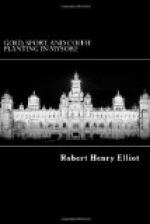In Mysore, notwithstanding the enormous quantity of forest land stretching along the Western Ghauts, there is, compared to the total area of forest, but comparatively little land, suitable for coffee, to be cleared. In the southern part of the province there is none, that I am aware of, worthy of the attention of Europeans, but one of the planters in the northern part of Mysore tells me that in that part of the country there is still much uncleared land, partly in the hands of the State, and partly the property of individuals. Such uncleared lands (and it is important when valuing a plantation to remember the following classification) may be divided into three classes, (1) the original forest, or, as the natives call it, mother jungle, that has never been touched by man; (2) the forest of secondary growth which has sprung up after the mother forest land has been cleared for grain growing, and abandoned after a crop or two has been taken from the soil; and (3) land on which young forest is growing, and which has never previously had any other forest on it. These three classes of lands are easily recognized by experienced persons, and even at a considerable distance. In the first there are large numbers of trees of great size, and often of timber of good quality. In the second there are no large trees, or perhaps only one or two samples of the original forest—generally mangoe, as they are often used as worshipping places—towering from fifty to sixty feet above the present level of the forest. In the case of the third, or young forest: this class of land may readily be recognized by the number of young Nundy and other deciduous trees. The first-named class of forest is of course by far the most valuable; the second will be more or less valuable according to the time that has elapsed since the mother jungle was felled—in some cases this may be only 40 or 50 years ago, in others from 50 to 100, and perhaps in some instances upwards of 150 years ago. In the last case, of course, the land will approximate in value to the mother jungle, but in the first there is an enormous difference in the value of the land, which will easily be understood when we consider what takes place when forest is cleared, burnt off and cropped. For in the tremendous conflagration that ensues, much of the accumulated wealth of ages is destroyed; and I may remind the reader that an iron peg driven firmly down till its head was level with the ground of a newly-cleared piece of forest, was found to be projecting no less than six inches from the surface after the fire was over. Then a crop is sown which indeed is not an exhaustive one, but it must be remembered that the land is exposed to heavy tropical rains, and perhaps for two years, after which it is abandoned, and allowed to grow up again into forest. So that the injury to the land from the burning of the forest, the removal of one or two crops of grain, and especially the loss from wash, bring about a state of exhaustion which a very




